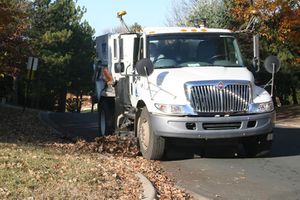
Difference between revisions of "Category:Level 3 - Best management practices/Nonstructural practices/Street sweeping"
m |
m |
||
| Line 3: | Line 3: | ||
Street sweeping (also called street cleaning) refers to removal of sediment, litter, or other accumulated substances on roadways, particularly in urban and suburban areas. Street sweeping does not include removal of large quantities of leaves brought to the street/verge for removal, large debris or bulky items; removal of these items is typically handled by large vacuum leaf collectors or dump trucks, respectively. | Street sweeping (also called street cleaning) refers to removal of sediment, litter, or other accumulated substances on roadways, particularly in urban and suburban areas. Street sweeping does not include removal of large quantities of leaves brought to the street/verge for removal, large debris or bulky items; removal of these items is typically handled by large vacuum leaf collectors or dump trucks, respectively. | ||
| − | Modern street sweeping has improved efficiency of debris removal from roadways dramatically. The focus of street sweeping was simple large “cosmetic” debris removal until the 1970s when concerns about water quality arose. In the decades following, improvements in street sweeping technology focused more on the removal and collection of coarse <span title="Particles with a diameter of between 0.075 and 4.75 millimeters (ASTM basis). Sand is commonly divided into five sub-categories based on size: very fine sand (1/16 - 1/8 mm), fine sand (1/8 mm - 1/4 mm), medium sand (1/4 mm - 1/2 mm), coarse sand (1/2 mm - 1 mm), and very coarse sand (1 mm - 2 mm)."> '''sand'''</span> particle-sized street dirt, and smaller particles which contribute to instream sediment and nutrient pollution when swept off of or washed into waterways. | + | Modern street sweeping has improved efficiency of debris removal from roadways dramatically. The focus of street sweeping was simple large “cosmetic” debris removal until the 1970s when concerns about water quality arose. In the decades following, improvements in street sweeping technology focused more on the removal and collection of coarse <span title="Particles with a diameter of between 0.075 and 4.75 millimeters (ASTM basis). Sand is commonly divided into five sub-categories based on size: very fine sand (1/16 - 1/8 mm), fine sand (1/8 mm - 1/4 mm), medium sand (1/4 mm - 1/2 mm), coarse sand (1/2 mm - 1 mm), and very coarse sand (1 mm - 2 mm)."> '''sand'''</span> particle-sized street dirt, and smaller particles which contribute to instream sediment and nutrient pollution when swept off of or washed into waterways. More recently, there has been a focus on street sweeping to remove the <span title="Carbon-based compounds, originally derived from living organisms"> '''organic matter'''</span> produced by street trees (leaves, seeds, flowers, etc), which can contribute significant amounts of [https://stormwater.pca.state.mn.us/index.php?title=Phosphorus phosphorus] to runoff, especially in the fall during leaf drop. <span title="A mixture of solid particles and liquid droplets found in the air. Some particles, such as dust, dirt, soot, or smoke, are large or dark enough to be seen with the naked eye. Others are so small they can only be detected using an electron microscope."> '''Particulate matter (air)'''</span> also poses significant air-quality concerns when entrained in the air due to wind. |
This page contains links to pages that provide information on street sweeping for water quality. | This page contains links to pages that provide information on street sweeping for water quality. | ||
[[Category:Level 2 - Best management practices/Nonstructural practices]] | [[Category:Level 2 - Best management practices/Nonstructural practices]] | ||
Revision as of 19:42, 7 February 2023
Street sweeping (also called street cleaning) refers to removal of sediment, litter, or other accumulated substances on roadways, particularly in urban and suburban areas. Street sweeping does not include removal of large quantities of leaves brought to the street/verge for removal, large debris or bulky items; removal of these items is typically handled by large vacuum leaf collectors or dump trucks, respectively.
Modern street sweeping has improved efficiency of debris removal from roadways dramatically. The focus of street sweeping was simple large “cosmetic” debris removal until the 1970s when concerns about water quality arose. In the decades following, improvements in street sweeping technology focused more on the removal and collection of coarse sand particle-sized street dirt, and smaller particles which contribute to instream sediment and nutrient pollution when swept off of or washed into waterways. More recently, there has been a focus on street sweeping to remove the organic matter produced by street trees (leaves, seeds, flowers, etc), which can contribute significant amounts of phosphorus to runoff, especially in the fall during leaf drop. Particulate matter (air) also poses significant air-quality concerns when entrained in the air due to wind.
This page contains links to pages that provide information on street sweeping for water quality.
Pages in category "Level 3 - Best management practices/Nonstructural practices/Street sweeping"
The following 28 pages are in this category, out of 28 total.
C
M
R
S
- Street sweeping
- Street sweeping for trees
- Street Sweeping Phosphorus Credit Calculator
- Street Sweeping Phosphorus Credit Calculator How-to-Guide
- Street Sweeping Phosphorus Credit Calculator: User Guide
- Supporting information
- Survey of street sweeping crediting approaches
- Survey results for managing street sweeping materials
Media in category "Level 3 - Best management practices/Nonstructural practices/Street sweeping"
The following 12 files are in this category, out of 12 total.
- How-to-guide 12 20 2021 FINAL.pptx ; 1.79 MB
- Kalinosky2014StreetSweepingManual.pdf ; 4.89 MB
- Leaf P Research Selbig.pdf ; 1.76 MB
- Spreadsheet Calc draft F7A.xlsm.xlsx ; 174 KB
- Street sweeping survey.pdf ; 96 KB
